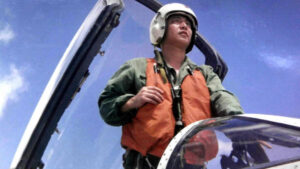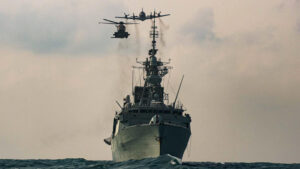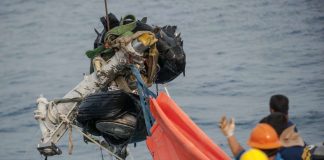JUNE 9, 2022

A Chinese J-16 fighter jet, in an undated photo released by Taiwan’s defense ministry. Australia said a J-16 harassed one of its surveillance planes over the South China Sea last month. – Taiwan Ministry of Defense, via Associated Press
HONG KONG — Chinese jets repeatedly buzzed a Canadian plane monitoring North Korea, sometimes coming so close that the pilots could see each other. Hundreds of miles to the south, a Chinese fighter plane sprayed metallic chaff in the path of an Australian surveillance craft, a maneuver that Australia called “very dangerous.”

An image from a video released last month by Russia’s defense ministry, said to show a Russian Tu-95 bomber taking part in a joint exercise with China. – Russian Defence Ministry, via Reuters
To Chinese officials, these were reasonable responses to foreign military patrols that threatened China’s security. To the American allies, the Chinese pilots’ actions in recent weeks were worrying escalations, risking a midair collision or crash.
Such a mishap could trigger a broader conflict. “There are split-second differences between this being a passing headline and this being a major incident with enduring international ramifications,” said John Blaxland, a professor of security and intelligence studies at the Australian National University in Canberra.
The provocations in the Asia Pacific, and the rhetoric surrounding them, add to the growing tensions as China faces off against the United States and its allies.
In recent years, China has been increasingly assertive in the region, from building military infrastructure in the disputed South China Sea to sending ships and aircraft near islands claimed by both Japan and China. Last month, Secretary of State Antony J. Blinken called China the biggest challenger to the international order and said the United States would work with allies to curb its aggressive actions.
Beijing has denounced such efforts as attempts to thwart China’s rightful rise, saying it wouldn’t be constrained by American bullying. Last month, as President Biden visited the region, China and Russia sent bombers over the seas of northeast Asia in their first coordinated exercise since Moscow’s invasion of Ukraine. Chinese military aircraft regularly hold drills near Taiwan, the self-governing democracy that Beijing claims as its own.

Wang Wei, the pilot who died in a 2001 collision with a United States Navy plane, has been lionized in Chinese propaganda. – Agence France-Presse — Getty Images
The Russian attack on Ukraine has heightened concerns that China could similarly try to take Taiwan, potentially drawing the United States into a direct conflict over the island, which Mr. Biden last month promised to defend.
But the recent aerial encounters are a reminder of a more immediate potential flash point: a pilot’s misjudgment of a close encounter, which could trigger a deadly crash and an international incident.
It has happened before, as when a Chinese fighter jet collided with a U.S. Navy surveillance plane over the South China Sea in 2001. The Chinese pilot was killed, and the American EP-3E Aries II was forced to make an emergency landing on Hainan Island.
China held the American crew for 11 days. It allowed their release only after extensive negotiations and the release of a letter saying the United States was “very sorry” for the pilot’s death.
The incident has become a rallying point in China. The pilot, Wang Wei, was posthumously given the title “Guardian of Territorial Airspace and Waters,” and the date of his death, April 1, is still commemorated in extensive official propaganda.
Last year, the Communist Party tabloid Global Times interviewed an employee of the cemetery where Mr. Wang is buried, who said his grave was often covered with flowers and model aircraft left by mourners. She described reading the letter of one visitor who said he had joined China’s navy because of Mr. Wang.

The Canadian Navy frigate Winnipeg, accompanied by military aircraft, during a 2020 military exercise in the Asia Pacific. – Royal Canadian Navy, via Via Reuters
“He wants to protect the country like Wang Wei,” said the worker, Shen Lu. “I think it is because the spirit of our heroes has been influencing our next generation.”
But such commemorations mean that a confrontational model of flying is held up for new Chinese pilots to emulate, said Collin Koh, a research fellow at the Institute of Defense and Strategic Studies in Singapore.
“These incidents amply showed there has been no attempt to try to rein in the pilots,” he said, referring to the recent aerial encounters. “I think they encourage it, and one way is through Wang Wei.”
In confronting aircraft from Australia and Canada, China is challenging two close American allies. Each has its own difficult relationship with Beijing, and both are among the countries that the White House hopes will join a coordinated effort to constrain China.
Beijing appears intent on challenging those ties, pressing Washington’s allies to consider how closely they intend to follow its lead.
“Australia’s military planes have traveled thousands of miles to China’s door to conduct close reconnaissance in coordination with the United States’ Asia-Pacific strategy to threaten and deter China,” Song Zhongping, a Chinese commentator on current affairs, said in an interview.
“Australia must realize that it is not the U.S. military, and it cannot afford the cost of a military conflict with China or a mishap,” he added. “Australia must deeply realize that on this issue it is only a chess piece of the United States, a pawn.”
Encounters between rival militaries in international waters and airspace are relatively common, as countries send ships and aircraft on training missions and to monitor other nations’ responses. Close shadowing and radioed warnings are part of the standard response.
But Australian and Canadian officials said the Chinese pilots’ actions last month went well beyond the norm.
The Australian military said one of its P-8 aircraft was carrying out routine maritime surveillance in the South China Sea when a Chinese J-16 fighter intercepted it and carried out a “maneuver which posed a safety threat.”
Richard Marles, Australia’s defense minister, told reporters that the Chinese plane fired flares, then cut in front of the aircraft. It released chaff, which contains metal used to throw off missiles, some of which was caught in the engine.
“Quite obviously, this is very dangerous,” Mr. Marles said.
China said the Australian plane had approached the Paracel Islands and ignored warnings to leave. The Paracels, which China calls the Xisha Islands, are a Chinese-held archipelago in the South China Sea that is also claimed by Vietnam and Taiwan.
“It is the Australia side that confuses black and white, repeatedly disseminates false information and instigates the hostility and confrontation,” said Senior Col. Tan Kefei, a spokesman for the Chinese defense ministry.
Canada said its CP-140 Aurora patrol craft had several troubling encounters with Chinese jets in international airspace while supporting the enforcement of United Nations sanctions imposed on North Korea. The Canadian crew was based in Kadena, Japan, during the monthlong mission, which ended on May 26.
Such work typically involves long, monotonous flights to monitor illicit trade, like clandestine fuel transfers at sea to circumvent U.N. restrictions on selling oil to North Korea.
China, as a member of the United Nations Security Council, supported the sanctions that the Canadians were helping to enforce, Professor Blaxland noted. He called China’s harassment of the surveillance flights “the application of a finely tuned set of double standards to threaten, cajole and punish Canada for complying with directives that it signed up to.”
The Chinese defense ministry accused Canada of using the U.N. mandate as an opportunity to monitor China, the North’s neighbor. Canada “stepped up close-up reconnaissance and provocations against China under the pretext of implementing the United Nations Security Council resolutions,” said Senior Col. Wu Qian, a ministry spokesman.










































































































